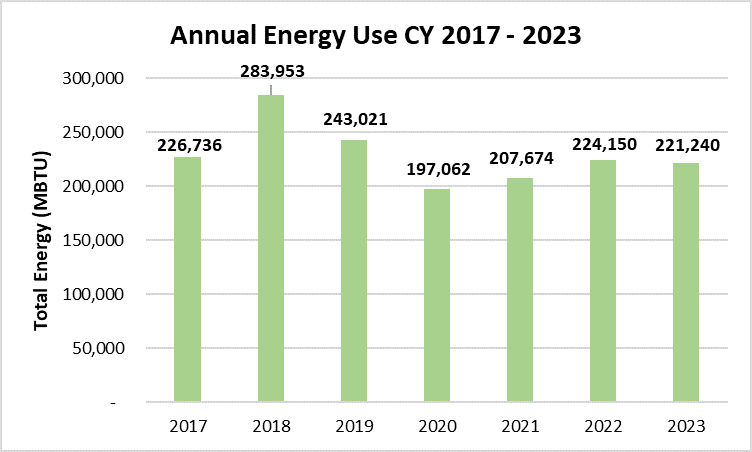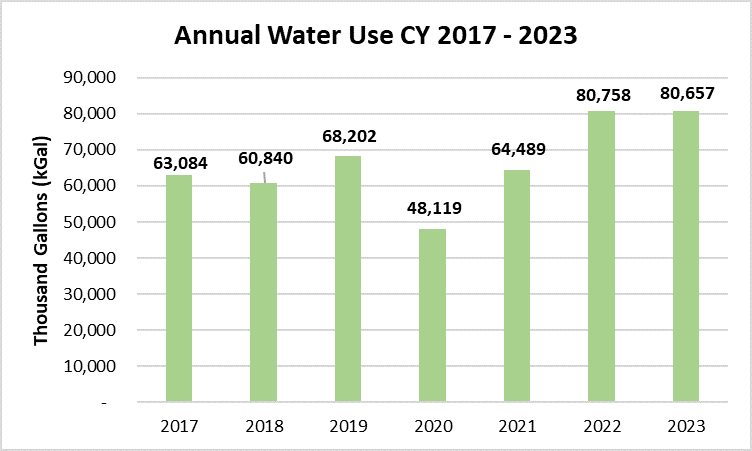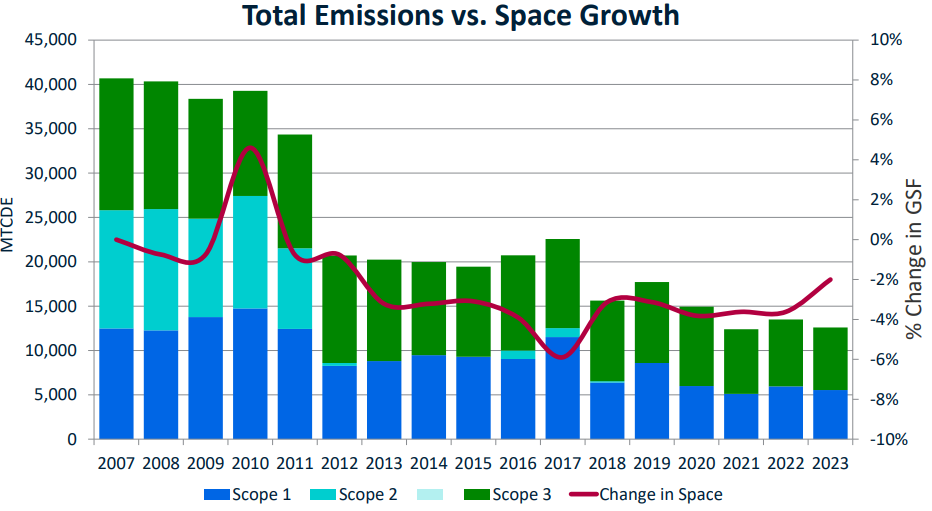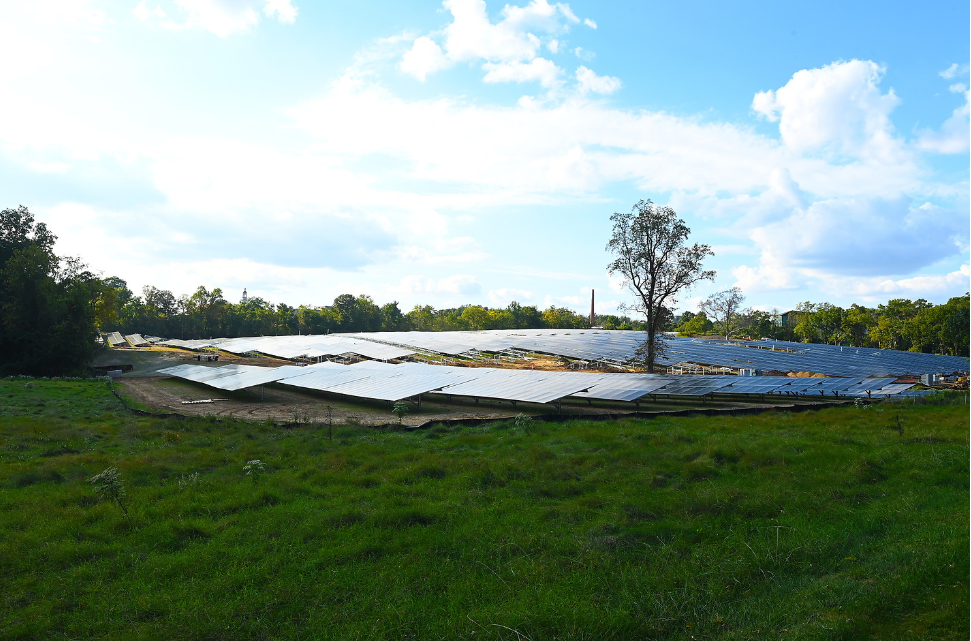The Office of Campus Sustainability, along with the Facilities Planning and Management team, continuously monitor metrics related to Catholic University’s use of energy and water utilities as well as generation of waste and greenhouse gas emissions. These metrics help us understand Catholic University’s environmental impact as well as provide insight into campus operations to support decision making.
The decreases in energy use, water use, waste generation, and greenhouse gas emissions over the past year are an encouraging sign of Catholic University’s commitment to its environmental impact. The campus aims to maintain these decreases with the continued implementation of the Sustainability Plan (2021-2025). To accomplish this and make long-lasting impactful changes, coordinated action is needed from all students, faculty, and staff.
Energy
Energy use accounts for the majority of campus utilities. The energy required to power all heating, ventilation, and air-conditioning (HVAC) campus equipment is supplied either through electricity or natural gas. Electricity is used primarily for cooling, lighting, and powering general appliances and computers. Natural gas is used primarily for powering boilers and other steam system components that warm buildings on campus.

Trends. While there was a clear increase in energy use from calendar year 2017 to 2018, there has been a decline in energy use since 2018. The significant decrease in 2020 was largely due to the decrease in occupancy on campus during the pandemic. In 2021, we started seeing an increase in energy use because faculty, staff, and students returned to campus on a more regular schedule, which followed the trend of the COVID-19 pandemic restrictions lifting. In 2022 and 2023, energy use increased due to full occupancy of the campus, however, it remained lower than it was in 2017, showing that the University is headed in the right direction.
Goal. By fiscal year 2025, the University aspires to reduce energy use by 20% compared to 2016, which is equivalent to saving 49,943 MBTUs. This is equivalent to the CO2 emissions from 760,932 gallons of gasoline consumed or the greenhouse gas emissions from 1,436 vehicles driven for a year.
Ideas for Saving Energy
To help us achieve this goal, students can make minor changes to their daily habits to save energy:
- Take a walk around campus once a day to reduce your screen/lighting time and provide you with some fresh air.
- Turn off lights and use natural lighting in the residence halls to reduce lighting time and improve your mental health.
For more tips, read our blog post about how you can help conserve energy on campus!
Water
On campus, water is used for faucets, toilets, and showers as well as to heat and cool buildings.

Trends. Water use was consistent from 2017 to 2018, but increased slightly in 2019. In 2020, there was a significant decrease in water use, which can be attributed to the COVID-19 pandemic which sent faculty, staff, and students home. Water use increased by 170% in April 2021 compared to April 2020 which can be attributed to the return of campus activity. However, water use in 2021 still reflected a decrease of 6% compared to pre-pandemic levels in 2019. Water use increased significantly in 2022 and 2023, although there was a slight decrease in 2023 compared to 2022.
Goal. By fiscal year 2025, the university aspires to reduce water use by 20% compared to 2016, which is equivalent to 14,643 kGals saved; enough water to fill 22 Olympic-sized swimming pools.
Ideas for Saving Water
To help us achieve these savings, students can make small changes to reduce their water use:
- Turn off the tap while you brush your teeth to save one to two gallons of water per minute of brushing.
- Challenge yourself to spend 1-2 minutes less in the shower per day to save five gallons of water per minute!
For more tips, read our blog post about how you can help conserve water on campus!
Waste
Waste refers to all items discarded and removed from the University, including recycling, compost, and trash. The Pryzbyla Center contains three-way separation bins for trash, recycling, and compost. Elsewhere on campus, you can find trash and recycling bins dispersed throughout the residence halls, administrative buildings, and academic buildings.

Trends. University waste data is available starting in 2020. From 2020 to 2021, we saw a significant increase in trash generation (waste sent to landfill), which can be attributed to the increased use of masks, cleaning supplies, and single use items during the COVID-19 pandemic. While this continued in 2022, from 2022 to 2023, we saw a decrease in trash generation. Similarly, the diversion rate of waste which decreased during the pandemic to a low of 21% in 2021, increased to 33% in 2022 and to 43% in 2023.
Goal. By 2025, the university aspires to divert 50% of waste generated on campus from landfill.
Ideas for Reducing Waste
To achieve our 50% diversion rate goal, there are many ways students can help reduce waste on campus:
- Invest in a reusable water bottle, straws, and cutlery to avoid disposable items.
- In residence halls, use reusable wash clothes and toiletry products.
- If you own furniture, clothes, or decorations that break, try to fix the item instead of discarding it and buying a new one. You might even learn a new skill!
Greenhouse Gas Emissions
Greenhouse gases are emitted as the result of everyday activities such as turning on lights and driving to campus. These emissions, which include gases such as carbon dioxide, methane, and nitrous oxide among others, contribute to global climate change. To learn more about the impact of emissions on climate change, review the Fourth National Climate Assessment.
In FY 2023, Catholic University emitted 14,530 metric tons of carbon dioxide equivalent emissions. This is equivalent to the GHG emissions from 3,233 passenger vehicles driven for one year or 37 million miles driven by an average passenger vehicle. It is also equivalent to the CO2 emissions from 1.6 million gallons of gasoline consumed or 1.8 billion smartphones charged.

Trends. Since the University first started tracking emissions in FY 2007, it has reduced total emissions by over 50%. Recent years show a gradual decline in overall emissions, despite an increase in the space on campus due to the opening of Garvey Hall and the construction of the new nursing and sciences building.
In GHG inventories, emissions are broken into three categories to better understand the source of emissions and how to control them.
Scope 1 emissions are emissions that an organization can directly control. This category includes on-campus natural gas use, fleet fuels, and refrigerants. Scope 1 emissions decreased in FY 2023 compared to FY 2022.
Scope 2 emissions are emissions from purchased electricity sources, such as electricity, steam, heat, and cooling. Catholic University has zero scope 2 emissions due to the purchase of Renewable Energy Credits (RECs). RECs ensure that the electricity we purchase is offset with the generation of renewable energy.
Scope 3 emissions, which are the most difficult to measure and control, include emissions from sources that are not owned or controlled, but that the organization indirectly impacts. Scope 3 includes emissions from commuting, travel (including study abroad and directly financed University travel), waste generation, wastewater, paper purchases, and transmission and distribution losses (associated with electricity use on campus). Scope 3 emissions have also decreased in recent years.
Goal. By the end of FY 2025, the University aspires to reduce carbon emissions by 20% compared to FY 2016 levels, which is equal to 4,162 metric tons of carbon dioxide equivalent (MtCDE). This is equivalent to charging 506 million smartphones or powering 501 homes.
Ideas for Reducing Greenhouse Gas Emissions
- Reduce energy and water use on campus.
- When feasible, consider using alternative transportation methods to get around town. MetroBus, MetroRail, carpooling, biking, scooters, and walking are all ways to reduce emissions. Visit the Catholic’s Transportation and Parking office to learn more.
- Recycle and compost using the recycling bins across campus and compost bins in the Pryz and Garvey Hall.

